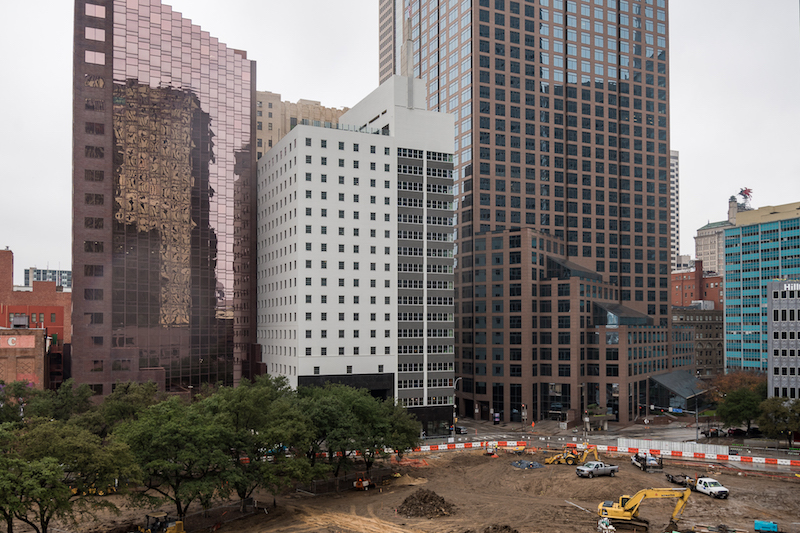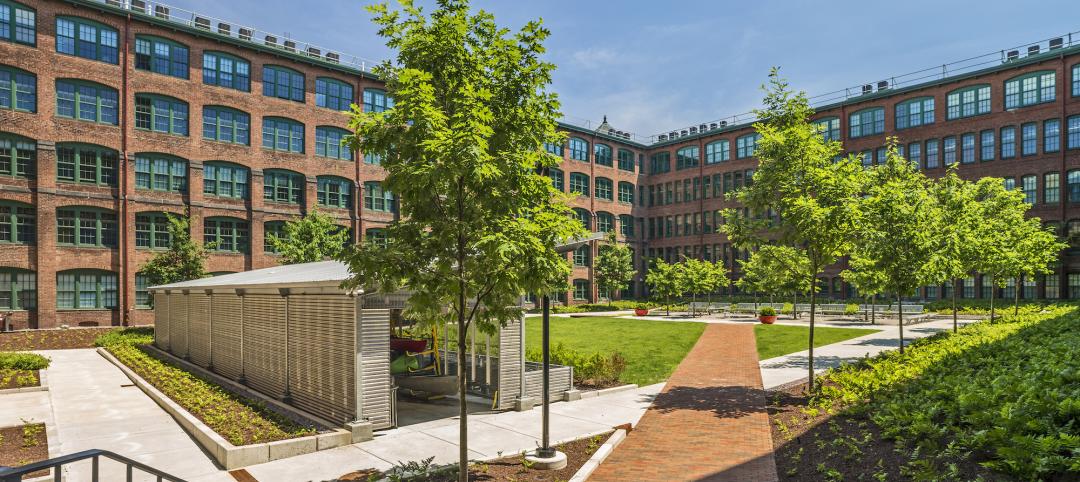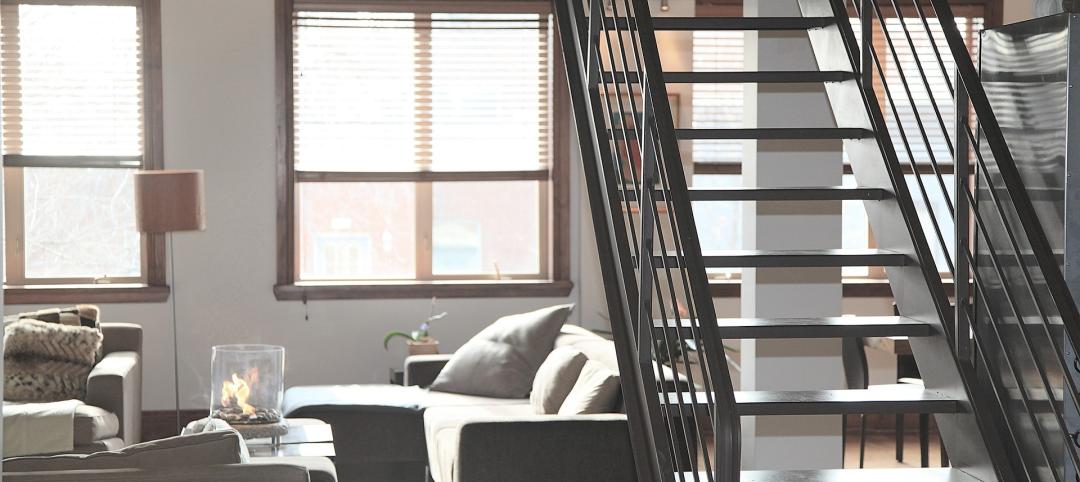For many years, Corrigan Tower, originally designed in 1950 by architect Wyatt C. Hedrick and constructed starting in 1952, provided rentable office space on Elm Street in downtown Dallas. Named for Owner/Developer Leo Corrigan, the building was designed to sit atop the existing Tower Theater, one of the prominent entertainment venues along Elm Street that rivaled the Majestic Theater to the east.
Corrigan had earlier acquired the adjacent Tower Petroleum building, which lacked central air-conditioning. The eventual construction of a mechanical penthouse on the 18th floor and cooling towers on the upper roof level of Corrigan Tower provided air-conditioning for both buildings. This shared mechanical system necessitated the buildings being connected from Level 17 down to the basement.
With the exception of the Majestic, which still survives, the other single-cinema theaters along Elm closed, Tower Theater among them. In the late 1970s, HKS Architects designed a multi-level retail court to occupy the volume of space remaining after the theater’s demolition. This created a contemporary and inviting entrance into Corrigan Tower from Pacific Avenue. The theater’s previous back-of-house area now saw a three-story glass curtain wall looking out onto Pacific. Structural steel framing and decking created mezzanines on levels 2 and 3 that featured multi-tenant spaces with boutiques and restaurants. This access from Pacific eased the traffic through the original entrance doors on St. Paul Street.
For the renovation of this 18-story tower, Andres Construction Services provided infilling for 150 apartments with luxury vinyl plank, large shower/bathtub combinations, and quartz countertops, as well as a 7,450-sf rooftop amenity deck and pool, a 4,220-sf amenity center, a 2,448-sf gym, and ground-floor retail space. The LEED-certified project now operates with up-to-date efficiencies, new windows, and upgraded mechanical systems to enhance resident comfort and reduce energy consumption.
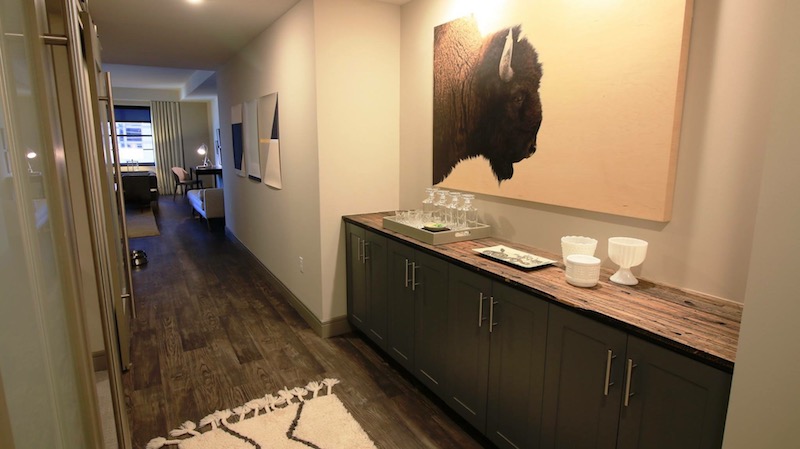
OVERCOMING DIFFICULTY IN CONSTRUCTION
Adaptive reuse projects pose unique challenges to construction. Add to that the duty of historic preservation—the building sits in the Downtown Dallas Historic District, with oversight by the National Park Service—and the difficulties compound quickly.
The replacement punched windows in the dwelling units and common areas and storefront window assemblies along Pacific and St. Paul had to match their predecessors exactly in appearance, design, proportions, profiles, and glass visual qualities. Andres Construction Services hand-sketched each condition, including punched and ribbon windows, to achieve an accurate profile in relation to the masonry.
We compared multiple glass types to ensure the proper match. The corner ribbon window glass had a blue tint, different from the single-punched windows, so we sourced glazed coating to recreate the look. The Park Service had previously approved replacing the original windows with a two-pane, thermally broken insulated assembly that measurably enhanced the thermal and acoustic performance of the windows. Removing the existing windows involved cutting four clips per window and pulling the window pieces inside.
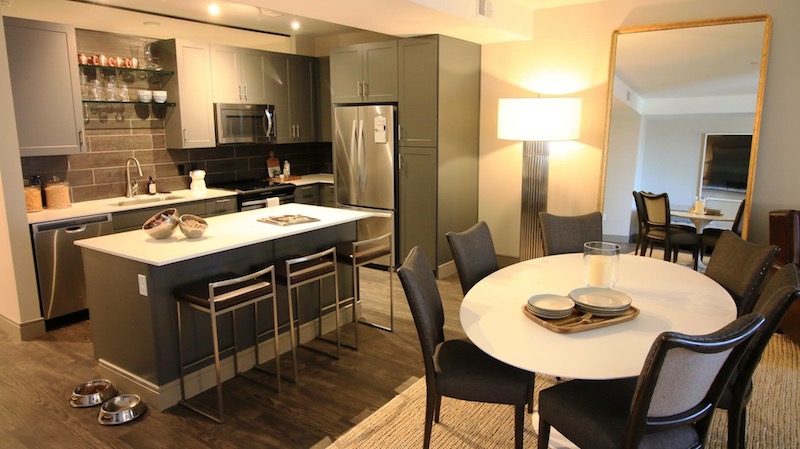
DEMANDING MASONRY WORK
Preparing the masonry openings for a modern six-inch-on-center mechanical fastener receiver system involved recess cutting in millwork blocking, metal sill flashing, peel-and-stick flashing, liquid-applied flashing, and sealant to ensure a long-term and well-preserved historic façade.
The lack of color photographs of the original construction made it difficult to provide a matching masonry coating. Dozens of breathable masonry coating mockups were analyzed to ensure the color and finish appearance coincided with the black-and-white photos the design team used for comparison. Accessing the building façade was made difficult due to the adjacent property’s courtyard and the city pedestrian sidewalks. Erectors built a scaffold system to reach the top of the spire 280 feet above ground level for technicians to point and patch the areas of the existing cast in-place spire structure. Flagpole experts climbed to the top of the pole over 300 feet above ground level to rerig the original flagpole. The building is now finished with appropriate colors, protected from moisture, and illuminated with RGB color-changing LED fixtures.
Preserving the existing elevator lobbies imposed logistical difficulties and in-place construction detailing. Protecting the existing stone veneer on the lobby walls from major demolition, existing interior masonry, and metal frame walls was an everyday task that involved close supervision and temporary protection with insulation board and plywood. Coordinating installation to meet up-to-date codes required fresh air and exhaust air duct. Concealing the duct above the ceilings created a conflicting elevation of the existing elevator hall lanterns. A specialty crew polished the metal and cleaned the hall lantern glass, while an elevator crew replaced the light fixture. An experienced millwork carpenter crafted custom plates to lower each fixture clear of the new ceilings.
The presence of the transfer trusses on the fourth floor challenged design architect Merriman Anderson Architects to harmonize apartment unit layouts marred by inflexible wall locations. Rather than trying to completely hide the trusses into the walls, in some areas the gypsum panels stayed with the truss layout so as to vaguely convey the truss’s profile. The openings in the webs of the trusses make for some unique cased openings and doorways in the apartment corridors and interiors of individual dwelling units. As there is a truss just inside the northern exterior wall of the building, some residual shelf nooks were created at the window openings.
Constructing a self-contained soldier-pile retention system for a three-sided structural concrete subgrade vault for the expansion of the underground power delivery infrastructure proved exceedingly difficult. This corner, at the very busy corner of St Paul Street and Pacific Avenue, is part of a hectic five-way downtown Dallas intersection with scores of other underground utilities
UNUSUAL CONSTRUCTION TECHNIQUES
Sealing existing/connecting stairs with a steel bridge took some doing. Cleaning and sealing rusty old stairs for the distressed yet clean look involved unusually precise amounts of prep time. Our painters were instructed to clean and sand just enough to allow the sealer to adhere, but not too much as to lose the antique or distressed look.
In order to update the stair egress requirements to current code, we built a C-channel, metal decking, and concrete bridge connecting existing stairs from a mid-landing to a new mezzanine structural level between levels 1 and 2. This allowed the existing stair to keep its grandfathered status, and also allowed the existing tread and riser dimensions to be maintained.
Andres Construction also built an Oncor vault to sustain the pressure of a full-height water flood.
DEBUT OF THE FINISHED PRODUCT
Shaker style cabinets, quartz counter tops, and luxury vinyl plank provide a durable finish with an elegant color pallet for 150 apartments. The open concept leasing office and amenity area on level two provides a welcoming environment with built-in seating and counters. Wood decking on the rooftop surrounds an illuminated pool with sunbathing areas and glass railing showcasing a magnificent downtown view.
Units became available for occupancy in July 2018, one month ahead of the contracted completion date. The 1900 Pacific Residences apartment community, developed by John Kirtland, President of 1900 Pacific Holdings, is 97% leased.
Related Stories
Reconstruction & Renovation | Feb 16, 2023
Insights from over 300 potential office-to-residential conversions
Research from Gensler finds that, surprisingly, the features that result in an unpleasant office often make for a superlative multifamily product.
Giants 400 | Feb 6, 2023
2022 Reconstruction Sector Giants: Top architecture, engineering, and construction firms in the U.S. building reconstruction and renovation sector
Gensler, Stantec, IPS, Alfa Tech, STO Building Group, and Turner Construction top BD+C's rankings of the nation's largest reconstruction sector architecture, engineering, and construction firms, as reported in the 2022 Giants 400 Report.
Multifamily Housing | Jan 23, 2023
Long Beach, Calif., office tower converted to market rate multifamily housing
A project to convert an underperforming mid-century office tower in Long Beach, Calif., created badly needed market rate housing with a significantly lowered carbon footprint. The adaptive reuse project, composed of 203,177 sf including parking, created 106 apartment units out of a Class B office building that had been vacant for about 10 years.
Adaptive Reuse | Jan 12, 2023
Invest in existing buildings for your university
According to Nick Sillies of GBBN, students are increasingly asking: "How sustainable is your institution?" Reusing existing buildings may help answer that.
Adaptive Reuse | Dec 21, 2022
University of Pittsburgh reinvents century-old Model-T building as a life sciences research facility
After opening earlier this year, The Assembly recently achieved LEED Gold certification, aligning with the school’s and community’s larger sustainability efforts.
Coatings | Dec 20, 2022
The Pier Condominiums — What's old is new again!
When word was out that the condominium association was planning to carry out a refresh of the Pier Condominiums on Fort Norfolk, Hanbury jumped at the chance to remake what had become a tired, faded project.
Sponsored | Multifamily Housing | Dec 14, 2022
Urban housing revival: 3 creative multifamily housing renovations
This continuing education course from Bruner/Cott & Associates highlights three compelling projects that involve reimagining unlikely buildings for compelling multifamily housing developments.
Mixed-Use | Dec 6, 2022
Houston developer plans to convert Kevin Roche-designed ConocoPhillips HQ to mixed-use destination
Houston-based Midway, a real estate investment, development, and management firm, plans to redevelop the former ConocoPhillips corporate headquarters site into a mixed-use destination called Watermark District at Woodcreek.
Multifamily Housing | Nov 29, 2022
Number of office-to-apartment conversion projects has jumped since start of pandemic
As remote work rose and demand for office space declined since the start of the Covid-19 pandemic, developers have found converting some offices to residential use to be an attractive option. Apartment conversions rose 25% in the two years since the start of the pandemic, with 28,000 new units converted from other property types, according to a report from RentCafe.
Reconstruction & Renovation | Nov 8, 2022
Renovation work outpaces new construction for first time in two decades
Renovations of older buildings in U.S. cities recently hit a record high as reflected in architecture firm billings, according to the American Institute of Architects (AIA).


